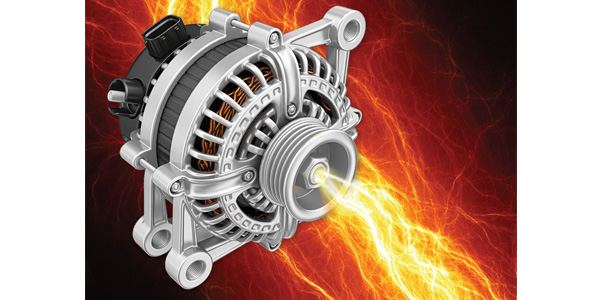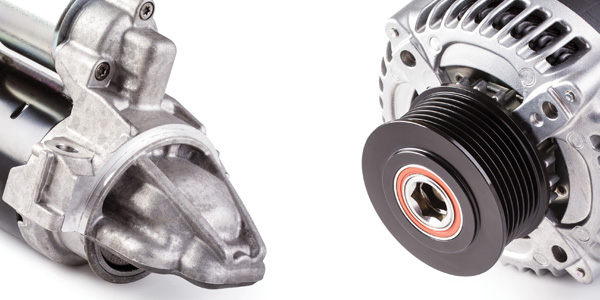
Alternators make amps, and starters use amps. As long as there is a happy balance between amps put into the battery and amps pulled out of the battery, the battery stays charged, the vehicle starts and life is good. The amps produced by the alternator offset the amps used by the starter and the other electrical and electronic systems on the vehicle. And if the alternator can’t make enough amps, the battery will make up the difference.
What exactly is an amp? It’s a unit of measure that describes current flow in an electrical circuit (similar to water flowing through a pipe). Plug your cell phone into a USB port to recharge it and you’ll use about 1 to 2 amps. This may not sound like much current, but in reality it is a HUGE number of electrons (something like 6.2 with 18 zeros after it per second!).
Volts, on the other hand, are the force that pushes the electrons through the circuit (like water pressure in a pipe). Ordinary lead-acid car batteries are 12 volts, although a fully charged battery will actually read 12.66 to 12.7 volts. To push electrons (amps) back into the battery, the alternator’s output voltage must be higher than battery voltage, and typically ranges from 13.5 to 15.9 volts depending on the battery’s state of charge, the electrical load on the system and temperature.
Alternator ratings range from about 60 or 70 amps up to 150 amps or more on many late-model vehicles. Some high-output alternators can generate upward of 200 amps. The amp rating of the alternator is matched to the vehicle’s electrical system. Older vehicles with fewer accessories may only need a 70- or 80-amp alternator, while a newer vehicle with lots of electronics and accessories may need a 120- to 160-amp alternator.

Replacement alternators always should have the same or higher amp rating than the original unit to maintain the correct amp balance. But even this may not be enough if a vehicle has been equipped with a high-amp aftermarket sound system or auxiliary lighting. It may be necessary to upgrade to a higher-output alternator.
Amp loads vary a great deal depending on the battery’s state of charge, what electrical devices are being used and how much power they consume. Cranking an engine on a cold morning may pull upward of 200 amps or more from the battery. Prolonged cranking can drain the battery very quickly and overheat and damage the starter. The amps used to start the engine have to be replaced once the engine starts.
Additional amp loads that have to be offset include the ignition system (4 to 6 amps) fuel pump and injectors (6 to 8 amps), headlights (15 to 40 amps), electric defrosters (20 to 25 amps), heated seats (5 to 7 amps per seat, wipers (6 amps), A/C or heater blower motor (15 to 20 amps on high) and/or sound system (10 to 40 amps). Add up various combinations of these loads and its easy to exceed 100 amps.
An alternator only produces a fraction of its peak-rated output at idle because output depends on speed. The engine usually has to be revved above 2000 RPM before the amp output really ramps up. Consequently, excessive idling with high amp loads, or short-trip infrequent driving with high amp loads, often leads to discharged batteries and overworked alternators. This, in turn, can lead to alternator overheating and premature failure.
If an alternator isn’t producing enough amps to keep the battery up, or if a starter seems sluggish or fails to crank the engine, the battery, charging system and starting system need to be checked to determine what’s wrong. A questionable alternator or starter always should be bench-tested to verify its condition before it is replaced, to reduce unnecessary returns and warranty claims.












